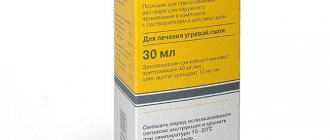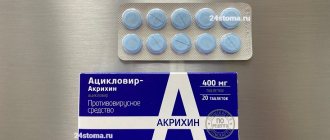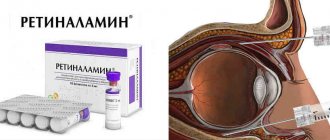Nicergoline lyophilisate d/d/in 4 mg 5 ml No. 5 + solution
Compound
For 1 ampoule, active substance: nicergoline - 4.0 mg; excipients: tartaric acid - 1.04 mg, lactose monohydrate - 30.0 mg.
Pharmacokinetics
90% of nicergoline is metabolized in the liver to form two main metabolites: 1,6-dimethyl-8?-hydroxymethyl-10?-methoxyergoline (MMDL, a hydrolysis product) and 6-methyl-8?-hydroxymethyl-10?-methoxyergoline (MDL, product of demethylation under the action of the CYP2D6 isoenzyme). Nicergoline actively (>90%) binds to plasma proteins, and the degree of its affinity for β-acid glycoprotein is greater than for serum albumin. It has been shown that nicergoline and its metabolites can be distributed in blood cells. The pharmacokinetics of nicergoline is linear and does not change depending on the age of the patient. The ratio of the values of the area under the “first pass” curve. Studies confirm the absence of accumulation of other metabolites (including MMDL) in the blood. The secondary metabolic pathway produces 1-dimethylnicergoline via demethylation (1-DN), which is then metabolized by hydrolysis of the ester linkages to MDL. In patients with impaired renal function, there is a significant reduction in urinary MDL secretion. Bioavailability is about 60%. The half-life of the drug is about 2.5 hours. The half-life of the main metabolite (MDL) is 13-17 hours, and the second metabolite (MMDL) is from 2 to 4 hours. Nicergoline is excreted in the form of metabolites, mainly through the kidneys (approximately 80% of the total dose), and in a small amount (20%) through the intestines. In patients with severe renal failure, there is a significant decrease in the rate of excretion of metabolic products by the kidneys compared to patients with normal renal function.
Indications for use
Moderate cognitive impairment in elderly people with vascular pathology, including dementia.
Contraindications
Recent myocardial infarction, acute bleeding, severe bradycardia, impaired orthostatic regulation, hypersensitivity to nicergoline or other components of the drug, pregnancy, breastfeeding, children under 18 years of age (due to lack of data). With caution: history of hyperuricemia or padagra and/or in combination with drugs that interfere with the metabolism and excretion of uric acid. Simultaneous use with sympathomimetics (alpha and beta), moderate bradycardia.
Directions for use and doses
Intramuscular, intravenous, intra-arterial. Intramuscularly - 2-4 mg twice a day. 4 mg is dissolved in 2 or 4 ml of 0.9% sodium chloride solution. Intravenous drip - 4-8 mg in 100 ml of 0.9% sodium chloride solution. If necessary, you can repeat the administration during the day. Intra-arterial - 4 mg in 10 ml of 0.9% sodium chloride solution, administered slowly over at least 2 minutes. The dose, duration of therapy and route of administration depend on the nature and severity of the disease. In case of acute disorders and if it is impossible to take the drug orally, it is necessary to begin a course of treatment with parenteral administration of the drug, followed by a transition to taking the oral dosage form. For patients with impaired renal function (serum creatinine ≥ 2 mg/dL), the daily dose is reduced by 25-50%.
Storage conditions
In a place protected from light, at a temperature not exceeding 25 ° C. Keep out of the reach of children.
Best before date
3 years. Do not use after the expiration date stated on the packaging.
special instructions
After intravenous administration of nicergoline, patients are advised to remain in a horizontal position for 10-15 minutes after injection due to possible orthostatic hypotension. Clinical studies have shown that with single or repeated use of nicergoline, a decrease in systolic and, to a greater extent, diastolic blood pressure can be observed in patients with normal values and with high blood pressure. Nicergoline inhibits platelet aggregation and reduces blood viscosity. Therefore, more frequent monitoring of blood coagulation parameters is required in predisposed patients. Cases of fibrosis (eg, lung, heart, cardiac valves, and retroperitoneal fibrosis) have been identified due to ergot alkaloids, which have serotonin 5-HT2? receptor agonist activity. Symptoms of ergotism (including nausea, vomiting, diarrhea, abdominal pain, peripheral vasoconstriction) have been reported with the use of ergot alkaloids and their derivatives.
Description
Porous mass or powder, white or almost white, odorless.
Conditions for dispensing from pharmacies
On prescription
Dosage form
lyophilisate for the preparation of solution for injection
Use in children
Contraindicated in children under 18 years of age (due to lack of data).
Manufacturer and organization accepting consumer complaints
Company DEKO, LLC
Pharmacodynamics
Nicergoline is a synthetic derivative of ergot alkaloids, with an attached bromo-substituted nicotinic acid residue. Increases the speed of blood flow in the vessels of the upper and lower extremities, especially in case of circulatory disorders. Reduces platelet aggregation and improves hemorheological blood parameters. Nicergoline exhibits an alpha-1-adrenergic blocking effect, leading to improved blood flow. It has a direct activating effect on cerebral neurotransmitter systems: noradrenergic, dopaminergic, acetylcholinergic, which leads to optimization of cognitive processes.
Side effects
From the digestive system: dyspeptic symptoms (nausea, diarrhea), constipation, abdominal discomfort. From the central nervous system: dizziness, headache, psychomotor agitation, confusion, sleep disturbance (drowsiness or insomnia). From the cardiovascular system: decreased blood pressure, feeling of heat. Allergic reactions: itching, skin rash. Local reactions: with intravenous administration - phlebitis; with intramuscular injection - pain, burning, thickening at the injection site. Other: “flushes” of blood to the facial skin, nasal congestion, development of fibrosis, symptoms of ergotism: gastrointestinal disorders (nausea, vomiting, diarrhea, abdominal pain), vasoconstriction of peripheral vessels, coldness of the extremities, pain in the extremities, paresthesia, anxiety, fear , loss of consciousness, change in mood or behavior, development of seizures. It is possible to increase the concentration of uric acid in the blood, and this effect does not depend on the dose and duration of therapy.
Use during pregnancy and breastfeeding
Nicergoline is contraindicated during pregnancy. If it is necessary to use the drug during lactation, breastfeeding should be discontinued.
Interaction
Strengthens the effect of antihypertensive drugs. Nicergoline has an antagonistic effect on the vasoconstrictor effect of sympathomimetics through its alpha-adrenergic blocking effect. The possibility of interaction of nicergoline with drugs metabolized by the CYP2D6 isoenzyme cannot be excluded. When used simultaneously with acetylsalicylic acid, other antiplatelet agents and anticoagulants, bleeding time may increase. Caution should be exercised when used simultaneously with drugs that affect the metabolism of uric acid. Nicergoline potentiates the effect of beta-blockers on the heart.
Overdose
Symptoms: transient marked decrease in blood pressure. Treatment: place the patient in a horizontal position; in exceptional cases, with a sharp disruption of the blood supply to the brain and heart, it is recommended to administer sympathomimetics under constant monitoring of blood pressure.
Impact on the ability to drive vehicles and operate machinery
During the treatment period, you should refrain from driving vehicles and machinery, as well as from performing work that requires increased concentration and speed of psychomotor reaction (including driving a car).
Nicergoline
The drug nicergoline with the same INN is a derivative of ergot alkaloids, which has an alpha-1-adrenergic blocking effect and acts as a corrector of cerebral circulatory disorders. It has a vasodilating effect (primarily in relation to the arteries of the brain), improves blood circulation in the microvasculature. The nicotinic acid residue contained in nicergoline has a direct antispasmodic effect on the muscular frame of resistive vessels (end arteries, arterioles, capillaries and venules), increases their permeability to glucose, especially the vessels of the brain and extremities. The drug improves cerebral, renal and pulmonary blood flow, reduces the resistance of central vessels, stimulates arterial circulation, increases the delivery of glucose and oxygen to the brain and other organs and tissues, improves blood flow in the extremities, incl. in case of circulatory failure due to developed functional arteriopathy (damage to the arterial walls). In the doses recommended in the instructions for use, nicergoline does not affect blood pressure. In hypertensive patients it can cause a gradual decrease to certain limits. With long-term use of the drug (2-6 months), positive changes are observed in patients with dementia (sustained decline in cognitive activity). Nicergoline inhibits platelet aggregation (sticking) abilities.
Nicergoline is available in two dosage forms: lyophilisate for the preparation of solution for injection and tablets.
The solution is administered intramuscularly, intravenously and intra-arterially. It is unlikely that anyone will give themselves an IV at home, much less intra-arterial injections, so these lekforms find their use mainly in hospitals. As for the intramuscular method of delivering the active substance to the body, after dissolving the substance in an isotonic solution (it is included in the package), 2-4 mg of the drug is administered. The frequency of administration is twice a day. The therapeutic effect develops gradually. The duration of pharmacotherapy is at least 2 months. The dosage regimen for the oral dosage form of nicergoline is determined individually. According to general recommendations, the drug should be taken 5-10 mg 3 times a day. The duration of treatment is more than 2-3 months. The standard tactics of pharmacotherapy using nicergoline is the initial use of the injectable form, followed by transferring the patient to the tablet form.
It should be noted that for patients with insufficient renal function and elderly patients, adjustment of the standard dosage regimen is required in the direction of reducing the doses used. An indicator for this is the serum creatinine level: if it is above 2 mg/dl, then it is necessary to reduce the dose. After intramuscular or intravenous administration of nicergoline, the patient should remain in a supine position for several minutes. During long-term treatment, the patient should periodically (every six months or more often) undergo a medical examination for a possible dose reduction or discontinuation of the drug.
Nicergoline liof solution for intramuscular injection 4 mg amp. in a set with solvent packing contact cell. N5
Registration Certificate Holder
NPO MICROGEN (Russia)
Dosage form
Medicine - Nicergoline
Description
Lyophilisate for the preparation of solution for injection
1 amp.
nicergoline 4 mg
Solvent:
sodium chloride solution 0.9% (5 ml).
4 mg - ampoules (5) complete with solvent (5 amps) - cardboard packs.
Indications
Acute and chronic cerebrovascular insufficiency (including cerebral atherosclerosis, dynamic cerebrovascular accidents, thrombosis and embolism of cerebral vessels), migraine, obliterating vascular diseases of the extremities, Raynaud's disease, arterial hypertension and hypertensive crisis (as an adjuvant) .
Contraindications for use
Acute bleeding, recent myocardial infarction, arterial hypotension, severe bradycardia, simultaneous use of alpha- and beta-blockers, pregnancy, lactation, hypersensitivity to nicergoline.
pharmachologic effect
Alpha adrenergic blocker. Improves cerebral circulation, activates brain metabolism. Reduces cerebral vascular resistance, increases arterial blood flow and oxygen and glucose consumption by brain tissue. Reduces pulmonary vascular resistance. Increases the speed of blood flow in the vessels of the upper and lower extremities, especially in case of circulatory disorders. Reduces platelet aggregation and improves hemorheological parameters. In patients with arterial hypertension, it may cause a gradual decrease in blood pressure.
Drug interactions
When used simultaneously with antihypertensive drugs, the antihypertensive effect is enhanced.
With simultaneous use, the effect of indirect anticoagulants and antiplatelet agents is enhanced.
Dosage regimen
Installed individually. Orally - 5-10 mg 3 times a day, course of treatment - 2-3 months or more.
IM - 2-4 mg 2 times a day. A single dose for intravenous drip administration is 4-8 mg, for intravenous administration - 4 mg.
In some cases, at the beginning of treatment it is administered intramuscularly or intravenously, then orally as maintenance therapy.
Side effect
From the cardiovascular system:
orthostatic hypotension and dizziness (especially after IM or IV administration), fainting, redness of the facial skin.
From the side of the central nervous system:
sleep disturbances, agitation, drowsiness, insomnia, anxiety, increased sweating.
From the digestive system:
nausea, diarrhea, increased acidity of gastric juice, abdominal pain, decreased appetite.
Allergic reactions:
erythema, urticaria.
special instructions
Patients with renal failure and elderly patients with serum creatinine levels greater than 2 mg/dL require dosage adjustment.
After intramuscular or intravenous administration of nicergoline, the patient must be in a horizontal position for several minutes.
During long-term therapy, patients should be examined at least once every 6 months, with a view to possible dose reduction or discontinuation of nicergoline.
Use during pregnancy and breastfeeding
Restrictions during pregnancy - Contraindicated. Restrictions when breastfeeding - Contraindicated.
Nicergoline is contraindicated for use during pregnancy and lactation (breastfeeding).
Use for renal impairment
Restrictions for impaired renal function - With caution.
Patients with renal failure with serum creatinine levels greater than 2 mg/dL require dosage adjustment.
Use in elderly patients
Restrictions for elderly patients - Use with caution.
Elderly patients with serum creatinine levels greater than 2 mg/dL require dosage adjustment.




